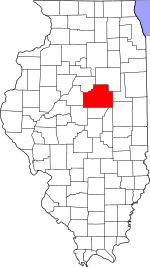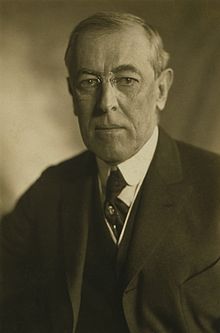from 1910 to 1919, ages 11 - 21
- 1910 Census Randolph, McLean County, Illinois
- 1912 School Exams, Bloomington Illinois
- 1913 Grace graduates; Woodrow Wilson president
- 1917 America enters World War I
- 1919 Women allowed to vote
1910, Census age 11
Randolph, McLean, Illinois |
| 1910 Census Randolph, McLean, Illinois |
The family starts with Joseph on line 65, on a Farm where he works as a Farm Manager. Grace is found on line 68, age 11, attending school.
 |
| Randolph Township (in red) within McLean County Illinois from Wikipedia |
 |
| McLean County within Illinois from Wikipedia |
Randolph County History
Randolph Township History Gardner Randolph settled here in 1823, the year following the Dawson-Hendrix settlement at Blooming Grove. Randolph spent his later life and died in California. Other settlers who joined Randolph in the 30's were Jesse Funk, Capt. John Karr of Revolutionary fame, the Rust family, the Nobles, Stewarts, the Wakefields and VanOrdstrands.Many mills were set up in this township along the Kickapoo creek. Michael Dickerson, William Hampton and Martin L. Bishop were early millers.Population of the township is 2,075. ["Official souvenir program, McLean County Centennial, Aug. 27, 28, 30, 1930" by: McLean County Illinois Centennial Souvenir Program Committee, Harold Lang and Eugene Funk (Transcribed by: Teri Moncelle Colglazier)]
HeyworthThe village of Heyworth [Randolph Township] was laid out by Campbell Wakefield in 1858 and incorporated in 1869.The town has become one of the best in the county, with paved streets, many business houses, excellent schools, churches and lodges. It has one newspaper, The Star, and a post of the American Legion.["Official souvenir program, McLean County Centennial, Aug. 27, 28, 30, 1930" by: McLean County Illinois Centennial Souvenir Program Committee, Harold Lang and Eugene Funk]Principal shipping point for the grain, stock, poultry and dairy farms in the south end of the county, the incorporated village of Heyworth today has a population of 1,072.It is situated on the Illinois Central and the Illinois Terminal railroads and on US 51. The village contains numerous retail stores, automobile and other service establishments, a postoffice, banking facilities and several tall grain elevators.Heyworth was founded in 1856 by Campbell Wakefield, early settler of the area. It was named after an English director of the Illinois Central Railroad, which had been built one year before the village was platted.Today, Heyworth is the principal community of Randolph Township, which has a total population of 2,022.First to settle in the township was Gardner Randolph, a second cousin of John Randolph of Roanoke. He came in 1823.[This is McLean County, Illinois by: John Drury, The Loree Co., Chicago, Illinois (1955)]
LytlevilleJohn Baldwin was founder of the village of Lytleville [in Randolph Township], which once aspired to be the county seat. When the Illinois Central railroad was built, Heyworth arose and Lytleville declined. ["Official souvenir program, McLean County Centennial, Aug. 27, 28, 30, 1930" by: McLean County Illinois Centennial Souvenir Program Committee, Harold Lang and Eugene Funk (Transcribed by: Teri Moncelle Colglazier)]
The Real Thing ad, 1910
The Des Moine Register, Des Moines Iowa
from Newspapers.com
RandolphJust north of Heyworth is located the small village of Randolph, with a population of twenty. An early resident of the village was John Moore, state legislator, colonel in the Mexican War and state treasurer; of Illinois in the early 1850's. [This is McLean County, Illinois by: John Drury, The Loree Co., Chicago, Illinois (1955) (Transcribed by: Teri Moncelle Colglazier)]
from Randolph Township History, McLean County Illinois, http://genealogytrails.com/ill/mclean/history_randolphtwp.html
 |
| Grace Tapp passes seventh and eighth grade exams The Pantagraph (Bloomington Illinois) April 1912 from Newspapers.com |
1912, age 13, Bloomington Illinois
Grace and her sister Olive passed seventh and eighth grade exams. They lived in Bloomington.If they lived in the north part of Randolph Township, the school in Bloomington would be about 4-5 miles away from home.
 |
| Grace in Graduation Ceremony The Pantagraph (Bloomington Illinois) May 1913, from Newspapers.com |
1913, age 14
Grace and Olive in McLean County School Commencement on Normal campus. They followed with a Picnic dinner at noon, a spelling contest and athletic events.
 |
| Miss Grace Tapp of Randolph The Pantagraph, Bloomington Illinois July 1914, from Newspapers.com |
1914, age 15, Randolph Illinois
Miss Grace Tapp is a guest at the Diamond Grove Women's Club
 |
| 1916 LeReveduBlesse |
1917, age 17
America Enters World War I1919, age 20
Historical Insight -- Women Gain the Constitutional Right to Vote
from Ancestry.com
Ratification of the 19th Amendment in August 1920 was the culmination of several decades of work by woman suffrage organizations.
 |
| Credit: Underwood Archives/Archive Photos/Getty Images |
(I have to say, look at the ladies' faces, then check out the face on the man on the left. What is that look?)
“The right of citizens of the United States to vote shall not be denied or abridged by the United States or by any State on account of sex.” To gain this brief addition to the U.S. Constitution in August 1920, woman suffrage movement leaders had met for 72 years to discuss their goal of gaining full voting rights throughout the United States. There were victories during this quest. Wyoming granted full suffrage to women in 1869, and every state from the Rocky Mountains to the Pacific Coast had extended full voting rights to women before 1920. When the 19th Amendment was ratified, only seven states remained where women had no voting rights at all. In the 1920 election, women did not vote as a political bloc, and a New York Times report estimated that one-third of the eligible female voters in the state cast ballots in the presidential election.
Media Gallery

On June 10, 1919, Wisconsin, Illinois, and Michigan became the first states to ratify the amendment.
The House of Representatives exceeded by 42 votes the number needed to pass the suffrage bill in May 1919.

Susan B. Anthony began to publish a women’s rights newspaper called The Revolution in 1868 with Elizabeth Cady Stanton.

Alice Paul shifted from suffrage to general equal rights as she led the National Woman’s Party for half a century.



No comments:
Post a Comment